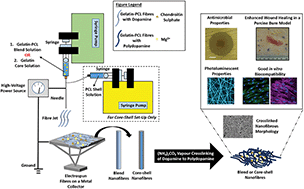Wound healing properties of magnesium mineralized antimicrobial nanofibre dressings containing chondroitin sulphate – a comparison between blend and core–shell nanofibres†
Abstract
The development of antimicrobial nanofibre dressings that can protect the injured tissues from commensal pathogens while promoting tissue regeneration finds enormous potential in plastic and reconstructive surgery practices. To achieve this goal, we investigated the effect of chondroitin sulphate on the morphology, mechanical properties, wettability and biocompatibility of polydopamine crosslinked electrospun gelatin nanofibres containing mineralized magnesium. To extend the durability of dressings, we prepared composite dressings containing polycaprolactone (PCL) and gelatin as blend or core–shell nanofibres. Nanofibre blends presented greater tensile strength and stretchability, while core–shell nanofibres displayed superior photoluminescent properties. In a porcine model of cutaneous burn injury, both the blend and core–shell nanofibre dressings displayed improved re-epithelialization, wound closure and clinical outcome in comparison to untreated burns. Histology of the biopsied tissues indicated smooth regeneration and collagen organization of the burns treated with core–shell nanostructures than untreated burns. This study compared the physico-chemical and biological properties of composite nanofibres that are capable of accelerating burn wound healing and possess antimicrobial properties, highlighting their potential as wound dressings and skin substitutes.



 Please wait while we load your content...
Please wait while we load your content...